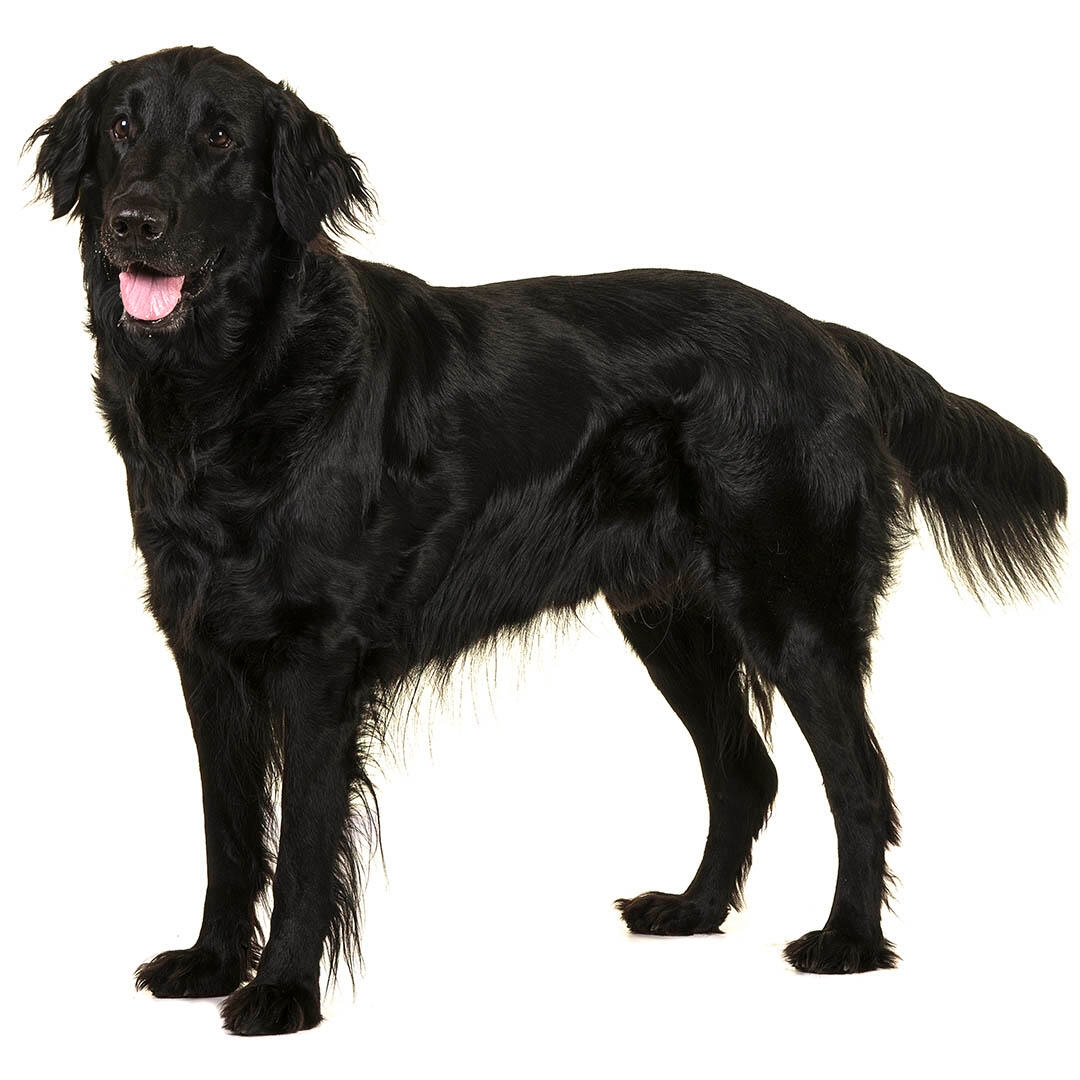
| Family-friendly: | 5/5 |
| Exercise needs: | 5/5 |
| Easy to train: | 4/5 |
| Tolerates being alone: | 1/5 |
| Likes other pets: | 5/5 |
| Energy level: | 5/5 |
| Grooming needs: | 3/5 |
| Shedding: | 3/5 |
Flatcoated Retrievers can be prone to:
- Hip dysplasia
- Elbow dysplasia
- Histiocytic sarcomas which are a serious type of cancer that starts in a particular type of immune cell.
- Glaucoma which is a painful condition where the pressure in the eye builds up.
Priority Kennel Club health schemes and testing:
- Hip dysplasia screening scheme
- Eye testing for pectinate ligament abnormality testing to look for signs that a dog is affected by glaucoma.
Kindly, lively yet gentle, the Flatcoated Retriever is less prone to the rather over-enthusiastic and potentially boisterous nature that some other retrievers are known for! Slow to mature and rather sensitive in nature, the Flat Coat is even-tempered and highly adaptable. A good family dog with the right training and an understanding home, the Flattie will enjoy accompanying family on long walks and taking part in training, and competitive dog sports. Snuggling up on the sofa is also a popular activity for the well-exercised Flatcoated Retriever!
| Family-friendly: | 5/5 |
| Exercise needs: | 5/5 |
| Easy to train: | 4/5 |
| Tolerates being alone: | 1/5 |
| Likes other pets: | 5/5 |
| Energy level: | 5/5 |
| Grooming needs: | 3/5 |
| Shedding: | 3/5 |
In the 1800’s landowners and the sporting nobility of Great Britain were heavily focused on producing recognisable types of working dogs with a specific job. In the Flatcoated Retriever’s case, their only purpose was to pick up and retrieve shot game, accurately and without damaging the flesh. Developed from the Lesser Newfoundland as a land retriever, they were further refined into an excellent water and land retriever and became much favoured by gamekeepers. The ‘Flattie’ is also well able to flush game from cover and hunt where necessary. First established by Mr. J Hull in 1864, the breed was extremely popular until the creation of the Golden Retriever, and two World Wars also took their toll on numbers. Now rising in popularity again as a pet and competition dog, the Flattie is an intelligent yet gentle breed and makes a delightful companion in the right home.
If you like your retrievers a little racier and leaner than the more common Golden or Labrador Retrievers, with a dash more thoughtfulness and sensitivity, the Flatcoated Retriever may fit the bill. Ideal owners will be fit and active, enjoy walking and training and perhaps take part in dog sports, gundog work or trick training. Good family dogs for the rural or semi-rural dweller with a decent sized and securely fenced garden.
Two hours of dog exercise a day is the bare minimum for the Flat Coated Retriever. This tireless worker is easily capable of long-distance walks, running, swimming and following scents. Keen to join in any activity, the Flattie is happiest when working with their person, at whatever activity is offered. A variety of walking routes and opportunities to swim would be ideal. Taking part in canine sports or pet gun dog training are all good outlets for a Flat Coat’s energy!
A secure garden is important, but the Flat Coat does not require a vast amount of space. Room to sprawl out and relax after a hard days walking or swimming, space to dry off after exercise and a comfy sofa to snuggle on will be all that’s necessary. As long as you can meet their need for countryside exercise, the Flat Coat will be happy housed almost anywhere, however keep in mind that noisy, bustling and busy locations will likely cause stress in any breed and this is very much the case for the sensitive Flat Coat.
Large breed dogs, as well as having large appetites, benefit from a different balance of nutrients including minerals and vitamins compared to smaller-breed dogs. The Flat Coated Retrievers are prone to bloating and stomach problems; smaller, more frequent meals can help minimise this risk. Discover more about how to offer your dog a balanced diet with our easy-to-follow guide.
Flat Coated Retrievers require daily brushing to maintain their coats. Particular attention should be paid to the feathers, which may collect debris, and their feet should be checked for dried mud or other foreign matter. Find out more about dog grooming and daily care with our article.
The Flat Coated Retriever will enjoy dog training with a patient, highly motivating trainer. Plenty of food and toys as rewards, plus the opportunity to tug, retrieve and follow scent will get the Flattie on-side. Beware however, the Flattie is easily bored and surprisingly sensitive, so keep training rewarding, fun and engaging, and provide variety as the Flat Coat can switch off easily and decide ‘not today thanks’ if things become too repetitive.
The Flat Coated Retriever is a sensitive breed and slow to mature, meaning puppies need careful raising in a quiet, steady environment. This plus the time and exercise requirements for adults means that they are better suited to a home with older children or teenagers, rather than a young family with very small children. Older children and teens who enjoy long walks and dog training will find the Flat Coat a loyal, gentle and loving companion.
While many dogs are traditionally thought of as being good with children, all dogs and children need to be taught to get on with each other and be safe together. Even so, dogs and young children should never be left alone together and adults should supervise all interactions between them.